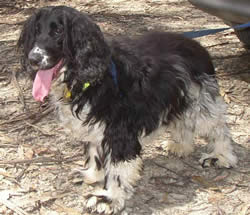Cataracts in Dogs
Symptoms, Causes, Treatment and Prevention
“Cataract surgery has a 90-95 percent success rate, assuming that your
dog is a good candidate for the procedure.”
Cataracts are the most common of dog eye problems. Cataracts in dogs frequently occur after a dog is six years old (senile cataracts). They can also occur as a result of diabetes, injury, or at a younger age because of heredity.
Overview/Snapshot of Disease or Condition
There are a number of breeds which are predisposed to developing cataracts, such as Cocker Spaniels, Huskies, Miniature Schnauzers, Poodles, Bichon Frises, some Terriers and some Retrievers.
Cataracts in dogs can be successfully treated. If cataracts are caused by disease or illness, such as canine diabetes, then treating the disease itself may sometimes improve the condition.
Vets can also prescribe medicated eye drops for cataracts which sometimes help. However, the most common and successful method for treating cataracts is surgery. Cataract surgery has a 90-95 percent success rate, assuming that your dog is a good candidate for the procedure.
Cataracts in Dogs – Symptoms
 Cataracts in dogs are usually easy to detect. Your dog may appear to have a bluish-white, milky film over one or both eyes. However, many dog owners mistake an eye condition called nuclear sclerosis for cataracts.
Cataracts in dogs are usually easy to detect. Your dog may appear to have a bluish-white, milky film over one or both eyes. However, many dog owners mistake an eye condition called nuclear sclerosis for cataracts.
Nuclear sclerosis is a common condition in older dogs where the eyes may appear to have a blue-gray cloudiness over the pupils. This is due to a normal thickening of your dog’s lens and it’s a natural part of aging. This kind of haziness is not the same as cataracts and it doesn’t affect your dog’s vision. Nuclear sclerosis does not need treatment.
Cataracts in dogs are different from nuclear sclerosis. They do affect your dog’s vision and, untreated, can lead to blindness. Your dog may be losing vision without your realizing it since dogs are very good at adapting to vision loss. It’s important for your dog to have regular eye check-ups with your veterinarian throughout his life. As with most other dog health problems, early diagnosis and treatment are best.
You can recognize cataracts in dogs by the following symptoms:
- Dog’s eye lens appears to have a white or crushed ice appearance
- Dog displays signs of blindness or loss of vision
Causes
Canine cataracts can stem from a number of causes including the following:
- Congenital cataracts present at birth. These cataracts usually form as a result of infections or toxins present during gestation.
- Developmental cataracts (early onset) develop early in life. This form of cataracts can result from trauma, disease such as diabetes mellitus, infections, or toxins.
- Senile cataracts (late onset) develop in dogs that are over six years old. This kind of late onset cataracts is often confused with nuclear sclerosis, which also clouds the eye lens but has a different appearance.
- Inherited cataracts occurs in some dogs as the result of having a predisposition for the disease. Breeds which have a higher incidence of inherited cataracts include Cocker Spaniels, Boston Terriers, Chesapeake Bay Retrievers, Golden Retrievers, Labrador Retrievers, Miniature Schnauzers, Old English Sheepdogs, Siberian Huskies, Staffordshire Bull Terriers, Standard Poodles, Welsh Springer Spaniels, West Highland White Terriers, German Shepherds and Afghan Hounds.
Treatment for Cataracts in Dogs
The most common and successful treatment for canine cataracts is surgery, which usually means the removal of the dog’s clouded lens. However, in some cases veterinarians may recommend other courses of treatment before trying surgery.
If infection or toxins are present, for example, treatment for these dog health problems may improve the cataracts problem. In some cases, treatment with medicinal eye drops can help some dogs. Nevertheless, surgery remains the most frequently used treatment. The success rate with this surgery is 90-95 percent, provided the dog is a good candidate for surgery.
Diabetic dogs may be treated surgically, provided they have been correctly regulated for several months. Dogs need to have a temperament that will allow them to accept eye drops and medication after surgery and they may need to wear an Elizabethan cone for a short time. The dog also needs to be in generally good health to come through the surgery well. The surgery can restore your dog’s sight to normal vision.
Prevention
The best prevention for cataracts in dogs is to make sure your dog has regular check-ups with your veterinarian throughout his life. There is no specific prevention for cataracts, but good veterinary care can prevent other dog health problems which may lead to cataracts.
Regular check-ups, including eye exams, will detect early changes in your dog’s eyes. Early detection is always the best way to prevent and treat any potential problems.
Return to Dog Diseases and Symptoms
Return from Cataracts in Dogs to Dog Health Problems
Return to Dog and Dog Advice home page